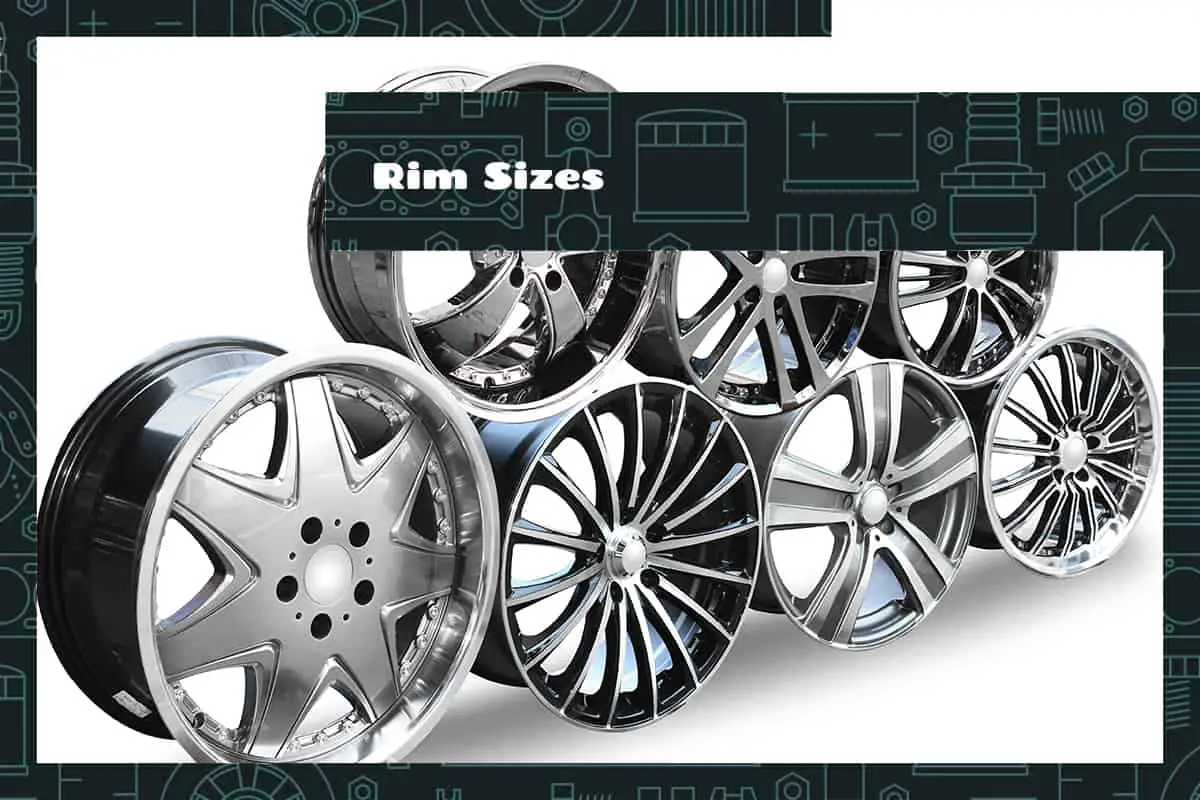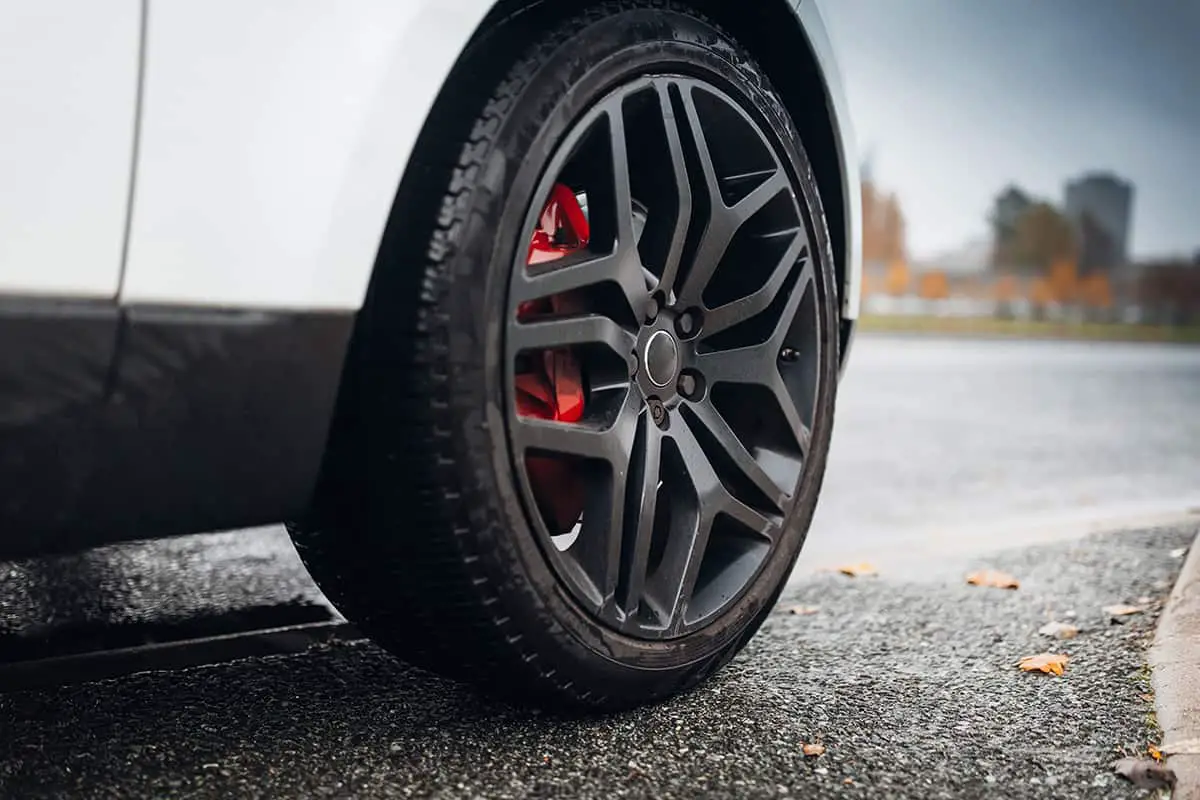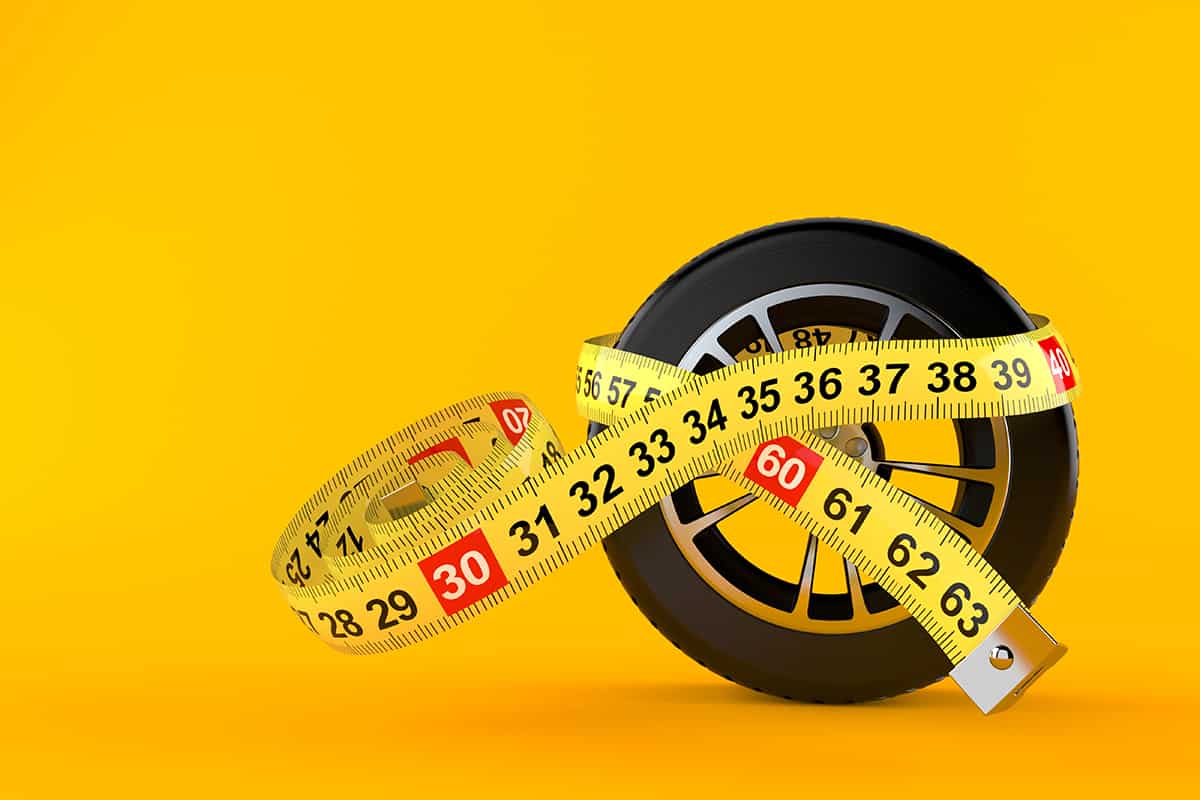Rim Sizes and Rim Width to Fit Tire Size Chart

Your car’s performance, safety, and even aesthetic appeal can largely depend on something you might not pay much attention to: the rim size. The rims, those metal structures that support the tires, play a critical role in your vehicle’s functionality.
They’re more than just flashy accessories that add to the car’s visual appeal. Correct rim sizes are crucial for ensuring a proper fit with your tires, impacting everything from fuel efficiency to handling and stability.
This guide will cover the intricate details of rim sizes, explaining their significance, how to measure them, and, most importantly, how to match them with the correct tire sizes.
Importance of Choosing the Right Rim Size

Rim size directly affects your car’s handling and stability. Larger rims often provide better handling, especially around corners, because they usually come with lower-profile tires, which reduce sidewall flex during turns.
However, too large rims can negatively impact stability as they can make the ride more susceptible to road imperfections and cause a harder ride due to less tire sidewall. Hence, there’s a fine balance that needs to be achieved to ensure good handling and stability.
Impact on Fuel Efficiency
Rim size can also influence your vehicle’s fuel efficiency. Generally, smaller rims with higher profile tires offer better fuel efficiency because they weigh less, thus reducing the amount of energy required to move the car.
Larger rims with lower profile tires, while they might look more appealing, tend to increase the vehicle’s weight, which can result in higher fuel consumption.
Impact on Ride Comfort
The size of your car rims can significantly affect the comfort of your ride. Smaller rims usually provide a smoother, more comfortable ride.
That’s because they’re typically paired with tires that have higher sidewalls (more rubber), which can absorb more road shocks from potholes or bumps. Conversely, larger rims tend to have lower profile tires, which result in a stiffer ride as they absorb less shock.
How to Measure Rim Size

With the right tools and knowledge, you can easily determine the specifications of your rims, aiding in the selection of appropriate tires and contributing to the overall performance and safety of your vehicle.
Required Tools
The good news is, measuring rim size does not require complex tools. A standard tape measure and a note pad to jot down your findings will suffice. For precise measurements, especially for rim width, a caliper can be beneficial.
Measuring Rim Width
To determine the rim width, you need to measure the distance from one inside edge of the rim to the other. Remove the wheel from your car for a more accurate measurement. Make sure you’re measuring the distance between the bead seats (the part of the rim where the tire rests), not the outer edges.
Measuring Rim Diameter
Rim diameter is measured in inches from the place where the tire seats on the rim, not the outer edges. To get the diameter, measure across the center of the wheel from one bead seat to the bead seat on the opposite side. Ensure your tape measure passes through the center hub for an accurate measurement.
Measuring Bolt Pattern
The bolt pattern, or bolt circle, is the diameter of an imaginary circle passing through the center of the wheel’s lug holes. It’s represented by two numbers, e.g., 5×120. The first number indicates the number of bolt holes, while the second signifies the diameter of the imaginary circle. To measure the bolt pattern, you need to measure the distance between the center of one lug hole to the center of the lug hole across from it.
Rim Width to Fit Tire Size Chart
A rim width to fit tire size chart is a helpful tool that can guide you in determining which tires will properly fit your vehicle’s rims. Here’s a general chart that illustrates the compatibility of various rim widths with different tire sizes.
| Rim Width (inches) | Minimum Tire Width (mm) | Ideal Tire Width (mm) | Maximum Tire Width (mm) | Suggested Tire Sizes |
| 5 | 155 | 165-185 | 195 | 175/70R13, 185/65R13 |
| 5.5 | 165 | 175-195 | 205 | 185/65R14, 195/60R14 |
| 6 | 175 | 185-205 | 215 | 195/65R15, 205/60R15 |
| 6.5 | 185 | 195-215 | 225 | 205/55R16, 215/50R16 |
| 7 | 195 | 205-235 | 245 | 215/50R17, 225/45R17 |
| 7.5 | 205 | 215-235 | 255 | 225/45R18, 235/40R18 |
| 8 | 215 | 225-255 | 265 | 235/40R19, 245/35R19 |
| 8.5 | 225 | 235-265 | 275 | 245/35R20, 255/30R20 |
| 9 | 235 | 245-275 | 285 | 255/30R20, 265/30R20 |
| 9.5 | 245 | 255-285 | 295 | 265/30R20, 275/30R20 |
| 10 | 255 | 265-295 | 305 | 275/30R20, 285/30R20 |
| 10.5 | 265 | 275-305 | 315 | 285/30R20, 295/30R20 |
| 11 | 275 | 285-315 | 325 | 295/30R20, 305/30R20 |
| 11.5 | 285 | 295-325 | 335 | 305/30R20, 315/30R20 |
| 12 | 295 | 305-335 | 345 | 315/30R20, 325/30R20 |
| 12.5 | 305 | 315-345 | 355 | 325/30R20, 335/30R20 |
| 13 | 315 | 325-355 | 365 | 335/30R20, 345/30R20 |
| 13.5 | 325 | 335-365 | 375 | 345/30R20, 355/30R20 |
| 14 | 335 | 345-375 | 385 | 355/30R20, 365/30R20 |
| 14.5 | 345 | 355-385 | 395 | 365/30R20, 375/30R20 |
| 15 | 355 | 365-395 | 405 | 375/30R20, 385/30R20 |
| 20 | 495 | 505-535 | 545 | 515/30R20, 525/30R20 |
The chart is quite straightforward to use. The first column represents the rim width in inches. The following columns represent the minimum, ideal, and maximum tire width that can fit the respective rim width, given in millimeters. For instance, if your rim width is 7.5 inches, the ideal tire width would be between 215 mm and 235 mm.
Consider a scenario where you have a vehicle with 8.5-inch rims. According to the chart, the minimum tire width that could fit this rim is 225 mm, the ideal range lies between 235 mm and 265 mm, and the maximum tire width should not exceed 275 mm. If you were to fit a 235-mm wide tire on this rim, you’d have a combination that falls within the ‘ideal’ range, ensuring optimal performance and safety.
Reading Tire Sizes
Tire sizes are usually represented as a string of letters and numbers (e.g., P215/65R15). Each part of this representation has a specific meaning:
- P: This letter stands for ‘Passenger.’ It indicates that the tire is designed for passenger vehicles. Other designations include ‘LT’ for Light Truck, ‘ST’ for Special Trailer, and ‘T’ for Temporary (as in spare tires).
- 215: This is the tire’s width in millimeters from sidewall to sidewall. In our example, the tire is 215-mm wide.
- 65: This is the aspect ratio, representing the height of the tire sidewall as a percentage of the tire’s width. Here, the sidewall height is 65% of the tire’s width.
- R: This letter stands for ‘Radial,’ which means the tire’s layers run radially across the tire.
- 15: This is the wheel diameter in inches. The tire is designed to fit a 15-inch wheel.
Tire Width Vs Rim Width

This post may include affiliate links. If you make a purchase through these links, we’ll receive a commission at no extra cost to you. This support helps us maintain and grow our site. Thank you for your support!
Tire width and Rim width are often confused for each other. You need to differentiate between tire width vs rim width to take care of your vehicle.
There is a permitted rim width range for each tire size, but there is a tire width range for each rim size, more precisely, rim width. Therefore, it becomes vital to understand the differences between the two sizes so that we are not confused about what to look for.
The width of your rims, also known as wheel width, is estimated from bead seat to bead seat. It’s the place where your tires and wheels make contact. On the other hand, the distance from one sidewall to the next is referred to as tire width. This is the major difference between the two.
While we have defined the major difference between tire width and rim width, they can be used on a wide range of rim widths because tires have flexible sidewalls. The rim width range of a tire refers to the smallest to largest rim widths that the tire is meant to be installed on across thousands of miles and years of operation. Therefore, we need to go deeper into the nuances of both tire width and rim width to understand all the differences between the two better.
It can be difficult for first-time vehicle owners and even some veterans to clearly understand what makes tire width different from rim width and vice versa. However, our information on tire vs rim width will alleviate some of their concerns as it is based on extensive research on authoritative sites spanning over 15 hours and my personal experience with car tires and wheels.
Table of Contents
What is Rim Width?
Consider a wheel that has been detached from the vehicle and is standing erect (ready to roll). When you glance at the wheel, the width is the distance between the wheel edges, also known as the wheel lips, from left to right.
The width of a wheel is measured in inches, usually in 1/2″ increments. A vehicle’s four factory wheels and tires are often the same width. A “square” configuration is what it’s called. The wheel and tire sizes at the front and rear axles are varied in a “staggered” layout.
What Is the Difference between Tires and Wheels?
The terms “wheels” and “tires” are not synonymous. Tires are part of the wheel setup. Your vehicle’s rims, for instance, have a set size, but you can buy alternative tire sizes to fit those rims as much as the center of the tires is the correct size. A car with larger rims, on the other hand, will typically be able to fit bigger tires than other cars.
How Do You Estimate the Right Wheel/Rim Width for Your Car?
When buying a new set of wheels, two factors should be taken into account: clearance and purpose. What exactly does “clearance” imply?
There is a gap between the tire and rim and the adjacent automotive parts within each wheel well. The amount of room available varies by vehicle. Some trucks have enough wheel well space to carry a substantially wider wheel than the original, but others can only fit a relatively wider rim than standard (if at all) without wheel well adjustment.
Clearance is the distance between your stock rims and all other automotive parts. Irrespective of whether a wider set of wheels can help you achieve your goal, you are first and foremost constrained by the available clearance.
An automotive technician will need to assess the gap between your stock rims and all adjacent components in order to determine clearance. Clearance should be checked at both the front and rear axles, as well as when the suspension is loaded.
While turning the steering wheel from one lock to another, make sure to take clearance readings in the front wheel wells.
If you’re hauling a trailer or driving through rough terrain, remember to factor in the extra vehicle weight, a compacted suspension system, and the resulting loss of clearance.
Always maintain a safe space between the rims, as well as all automotive parts in the wheel wells. Severe car damage and impaired vehicle safety can occur if the wheel and tire arrangement is overly wide. Automotive experts should handle clearance calculations and maximum wheel width suggestions.
Another significant factor to consider when choosing a wheel width is “purpose.” Staying with the OE wheel width(s) Front and rear is the best option if your goal with new rims is to improve or change the look of your vehicle.
The factory wheel widths were determined after extensive engineering and vehicle testing, so if there’s no strong performance reason to change them, then there simply isn’t one.
If you’re looking for a specific level of performance, a wider or tighter wheel than standard can be the way to go.
Winter tire and wheel combinations, for instance, are often narrower than normal wheels and tires. Because the wheels and tires have a smaller footprint, they can effectively “slice” through wintry precipitation.
On the other hand, off-road performance is usually improved by a larger wheel and tire footprint. Greater tire contact patch and traction in diverse off-road conditions are possible with a wider setup.
The same is true for high-performance commuting: a wider rim and tire setup can improve a performance car’s maximum grip level. Wider rims and tires are the standard for Track Days and driving events.
As a result, the choice of wheel width is based on clearance and use. Both variables must be taken into account to choose the right wheel/rim width for your car.
How Do I Determine My Rim Size and If the Rims Will Fit the Chosen Tires?
The simplest way to figure out the size of your stock car rims – also known as rim height or how high the wheel is – is to check your tire size information.
Both tire and wheel size is indicated by the final digit in your tire size (before the distinct load index and speed grade).
It’s a little more difficult to figure out how wide your wheels are. The tire section width, which is the first value in the tire size series and is stated in millimeters (“225” in the picture above), gives an indication of the wheel width but is not definitive.
This is due to the fact that any particular wheel diameter can accept many tire widths. For instance, a 225-millimeter section width tire can be mounted on an 8″ or 8.5″ wide wheel.
The dealership service department is frequently a helpful resource for determining wheel width and full specs details of your factory wheels. After that, you can hunt for substitutes or close matches using the entire stock wheel specification.
Now, another important thing many car owners want to know is if the tires they have chosen would fit the rim size on their car.
This is a common query from drivers who want to improve the look of their wheels while keeping their factory tires and not changing the vehicle’s performance.
As previously mentioned, the ideal (and safest) way when seeking a wheel upgrade for cosmetic reasons is to keep the stock wheel dimensions – this includes both rim width and diameter.
If these wheel specs are maintained, your original equipment (OE) tires will fit the replacement rims just as well. If you modify the rim width or diameter, for example, from an 18″ to a 19″, your factory tires will no longer fit on the rims.
What is Tire Width?
The proper installation of tires on your vehicle is critical to its overall performance and safety. Your tire selection should be based on the conditions you’ll be driving in as well as your requirements for vehicle responsiveness and handling.
When it comes to buying tires, though, you must know how to read tire size to make the best choice. It involves knowing what tire width is and estimating it accurately.
The width of the right tires for your car, in mm, is the first digit in your tire size information: 91S P225/70R16. The distance from one sidewall to the next is always referred to as tire width. As an example, a tire with the designation “P225” is designed for passenger vehicles and has a standard width of 225 millimeters.
How to Read Tire Sizes?
When looking for new tires, size designations like 235/75R15 and P215/65R15 will pop up. If you don’t know how to read these labels, they can be complicated, but once you master the language of tires, they become much clearer.
Three digits and sometimes letters can be found on the left side of the slash sign. The numbers represent the tire width in millimeters from sidewall to sidewall. The higher this number is, the more road impact the tire has.
The tire type is indicated by a letter on the left side. You might notice the following letters:
The letter “P” stands for passenger vehicle tire. This document also informs you that the tire is manufactured in accordance with US standards. When there isn’t a letter, it signifies it’s made to European specifications. The load capabilities of the two types are different.
“LT” stands for “light truck.” Tire sizes beginning with these letters are designed for light trucks. They’ll have greater psi suggestions to handle trailers and large loads more effectively.
The abbreviation “ST” stands for “special trailer.” Tire sizes denoted by these letters are only for trailer wheels.
We can know that a P215/65R15 tire is for a passenger car and has a 215-millimeter width by looking at it.
Two numbers, a letter, and two additional numbers can be found on the right side of the slash sign. The aspect ratio of the tire’s elevation to its width is represented by the first set of figures. These figures are 65 in our P215/65R15 example, indicating that the tire’s sidewall elevation is 65 percent that of the tire’s width.
The middle word on the right side of the slash indicates the tire’s construction method, which is usually “R,” which stands for radial. This indicates that the tire’s layers run longitudinally across it.
The last number is crucial since it indicates which wheel size the tire will fit. This number in our case is 15, indicating that the tire will fit a 15-inch diameter wheel.
What Is the Tire Width That Will Fit To My Car Wheel/Rim?
Tire widths suitable for the 6″ rim range from 175mm to 225mm. Since each wheel width correlates to only a few tire widths, the wheel width should be considered when replacing an OE (original equipment) tire with a wider aftermarket tire.
When we refer to tire size in this sense (the relationship between tire width and wheel width), we are referring to tire width (i.e., section width) and tire aspect ratio/series; wheel diameter is not included.
Not all tires available for your car model should be considered fit for your vehicle because only a few if any, would meet the criteria that their total diameter be almost identical to that of your OE (original equipment) tire.
So, when you identify tire sizes that match your wheels/rims, check tire dimensions against your OE tire size to make sure the correct tire circumferences or diameters do not stray too far from the OE tire circumferential or diameter. This is critical for a variety of reasons.
The sidewalls of a tire with a higher profile (series) for similar width or the same configuration for wider tire width have a higher profile, which signifies a smoother ride. Wider tires provide more traction on the road, which reduces fuel efficiency.
How Do I Find the Right Tire Size For My Budget?
In general, larger tires and wheels are better for enhancing traction in your car. According to Consumer Reports, however, larger tires come at a higher price.
Try to strike the right balance between size and price. If you choose larger wheels and tires when you buy your vehicle, you may not notice the price difference at first, but when you need to replace them, you will pay more than someone who drives a car with smaller wheels.
When it comes to tire replacements, once you’ve decided on a size for your car, you’ll want to stick with it. This is because a different-sized tire might cause your speedometer to malfunction and possibly compromise your car’s anti-lock brake systems and stabilization system calibrations.
This applies to both differently sized tire sizes. Changing to larger tires with an incorrect sidewall height can cause damage to your car’s axle, wheels, and tires, as well as result in inaccurate speedometer measurements.
Your odometer and speedometer should not change if you fit larger-diameter rim sizes to lower-profile tire sizes. Your tires will have narrower sidewalls, which means tighter sidewalls and a higher risk of implosions if you hit a pothole with this setup.
When replacing your tires, try to keep with the same brand and size, as combining might result in spinouts and loss of control.
Tire Width vs Rim Width: How Do the Two Relate?
The width of the wheel/rim will affect the tire’s width. A tire fitted on a narrow rim would be “smaller” than a tire mounted on a broad rim of the same size.
The industry standard is that for every 1/2″ increase in rim width, the tire’s section width will increase by roughly 2/10″.
A tire of the P205/60R15 size, for instance, is evaluated on a 6.0″ wide wheel and has a permitted rim width range of 5.5″ to 7.5″. When fitted on a 6.0″ wide rim, the tire has a sectional width of 8.23″ (209mm).
When evaluating a tire mounted on the tightest rim to the largest rim within its range, there is an 8/10″ predicted variation in tire section width due to the varying wheel widths employed. When choosing optional aftermarket rim and tire packages, this may affect fender well and frame clearances.
Furthermore, some car manufacturers have created Original Equipment applications with rim widths that are outside the tire’s original permitted rim width range.
These uses meet the car manufacturer’s criteria despite being beyond the normal suggested rim width limits.
Final Word
Your car’s wheels and tires are critical components. Though it may seem self-evident, many drivers don’t pay much care to the tires they purchase for their vehicles, which can lead to a slew of issues.
To guarantee that your wheels are safe and provide your car with the finest amounts of traction possible, get to know your automobile, including the difference between tire width and rim width, to avoid making costly tire blunders.
About The Author

I’ve spent many years selling cars, working with auto detailers, mechanics, dealership service teams, quoting and researching car insurance, modding my own cars, and much more.

Limited Slip Vs Posi (List Of Differences)

Honda HR-V vs CR-V: Which Is Best For You?

Honda Pilot Vs Toyota Highlander

Honda Accord Vs Toyota Camry
Recent Articles

Honda Vs Toyota: Who Triumphs in Car Reliability?

Honda Civic Vs Accord

Toyota Rav4 Vs Honda CR-V

Ford Maverick Vs Ranger
https://www.carshtuff.com/post/tire-width-vs-rim-width/
